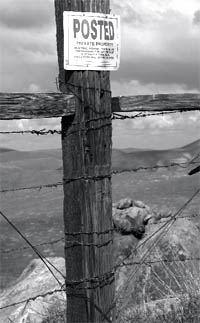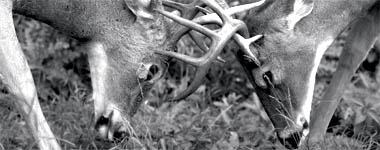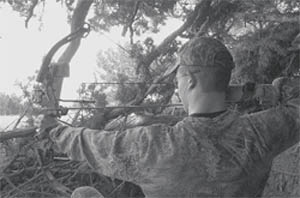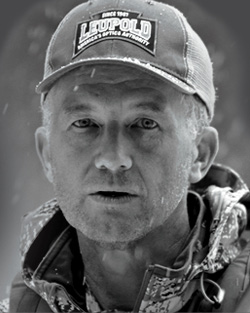Most conflicts solved with market-based solutions involve opposing sides exercising their property interest, whether factual or imagined. Wildlife resource battles in the Rocky Mountain West are no different. Mired in this struggle are landowners holding the property rights attached to their land, and public citizens and wildlife managers holding fast to their vested interest in wildlife.
I find myself in the eye of this storm. My personal and professional biases are based on my passion for hunting and fishing, and a 22-year career as a CPA helping clients maximize returns on their property rights.
The unique position afforded me by this strange professional and personal mix gives me a perspective shared by few others. So much of the conflict around wildlife has moved beyond property rights arguments to personal agendas and egos that one must wonder if we can come back to the efficient and common sense approach of utilizing our property interests for purposes of benefit, rather than grinding axes.
In its simplest terms, this struggle is based on private landowners’ private property rights vested to them under the Constitution. No person of sane mind argues the validity of these rights.
Being placed in opposition is the public trust doctrine—the principle that certain resources are held in trust for public use, and that the government has fiduciary requirements to maintain it for the public’s benefit. To try and determine the relevance this doctrine has to wildlife, I hired one of the most respected attorneys in wildlife law. The charge was to explain the history of the public trust doctrine and its application to the struggles currently playing out in the West.
To summarize his findings, the public trust doctrine is a powerful judicial concept and does validate the public’s claim to an interest in wildlife. His opinion provided explanation of how we got to this point of the wildlife argument, but made it clear that such doctrine is merely one consideration in the argument surrounding wildlife resources.
The long history and depth of conflict found in the private land/public wildlife struggle in the West makes it obvious that the solution will not be easy. So many attempts have been made—most with mixed success.
Access and Opportunity
There is no doubt the property right of access held by landowners is the trump card in the discussion. Without access, the public’s interest in wildlife has little value as it relates to wildlife on private land. How the landowner exercises this access right is partially determined by the state laws that govern the allocation of hunting opportunity.
As much as landowners hold the big club of access, and in many instances are not reluctant to use it, the public holds the ability to determine allocation of wildlife opportunity—how hunting licenses and tags are awarded to residents and non-residents, landowners and non-landowners. So far, states have not used their powers of wildlife allocation to deny opportunity to any class of citizens, and in many instances have allocated exclusive opportunity to landowners and their agents to accomplish some habitat or access objectives.
Why are we at this point? From my perspective, it is because both sides view their property interest to have priority, and at times, almost to the complete denial of the rights held by the other. And both obviously have different incentives and desired outcomes.
What end result provides the landowner the greatest return on her or his access rights? It is easy to say profits, but maximizing profits via fee hunting may come with problems such as overpopulation and habitat damage. Enrollment in a state access program, which generates less revenue, is an option that keeps animal numbers in line with available habitat but also comes with public hunter hassles.
What is the best outcome for the public trustees and their beneficiaries and wildlife resources? It depends on which trust beneficiary you talk to. More access? More opportunity? Greater trophies? All of the above? None of the above?
I suspect that if the public interest in wildlife was held by an individual or entity, this problem would have already been solved. The free market is that efficient. But such is not the case, so further effort and creativity is required.
It has come to the point where the landowner is realizing that his access trump card is only as valuable as the manner and way in which he chooses to play it. The state agencies are slower to come to the realization that their greatest leverage—license allocation—is a difficult tool to use. They rely upon public process and political change as mechanisms for action. Hardly the quick and efficient process afforded private property holders.
Solutions and Subsidies Don’t Mix
This discussion is not happening in a vacuum. Many other parties are exerting political influence to their benefit and, in most instances, to the detriment of the two parties with a real property interest in this argument.
A third party intervener who owns little or no property rights yet wants to have the majority of the economic activity funneled through them, is the outfitting industry. If ever exists a classic case of government interference distorting the outcomes of negotiations between two interest holders, it would be the manner in which western state governments directly and indirectly subsidize outfitting industries.
These businesses exist in many instances by taking the public asset of allocated hunting permits and leveraging it to create opportunity to purchase access, at far below the going rate. These intermediaries own none of the interests involved, but by state law require non-residents to use outfitters.

Until we honestly assess the problems government is creating with these subsidy programs for businesses with no real ownership interest in the wildlife or the land on which it lives, we will probably never see the value of market-based solutions. Creative answers using market principles are best served when market interference created by state subsidies is at a minimum. Regardless of who holds which property right, the rights are less valuable when a non-vested interest is allowed to extract the majority of economic benefit from this transaction.
As a free market advocate, I struggle trying to find a solution to a problem where the hunting transaction consists of two different property interests, held by two different parties, with two different incentives, being affected and almost manipulated by a third party holding none of the property rights in question.
If the history of this conflict had evolved differently, the result and options today would be equally different. Public trust beneficiaries are skeptical of landowner compensation programs, such as those in Colorado, New Mexico, and elsewhere. Landowners attribute this to public hunters wanting “something for nothing.”
A quick study of the legislative history related to landowner compensation programs shows that agreements are reached in good faith, only to morph into programs hardly resembling the original pact, and usually an increased benefit to landowners and detriment to public hunters. Such skepticism of public hunters is not without basis.
When the heat is turned up, states often find public support for ideas that put a stick in the eye of landowners, the holders of habitat. Since these state officials are elected or appointed, they have no bottom line accountability. Furthermore, there is no measurement criteria, so he or she relies upon feedback from public hunters to determine job performance. This feedback is usually biased in assessing the performance of the state trustee. Lack of accountability and subjective performance measurement does not lend itself to bold ideas and management by trustees.
In private industry, the simple measurement criteria are profits or increase in value. Like most market mechanics, profit-based measurements are effective and efficient. The same does not apply to publicly held property and the institutions vested with the fiduciary management of such property. Hunter/angler days, clean water, open spaces, equal allocation, indirect subsidy to those not able to pay, and many other factors make up the list by which agencies measure performance.
The American Way
Given these vast differences in perspective, incentives, and management, it is only expected that public wildlife and private property would be this strange mix we struggle with today. On the bright side, it is this uniquely American mix of private property and public wildlife that has created abundant wildlife to argue about. Both sides have evidence to show the importance of their contribution to this abundance. Countries with complete private ownership or full public control have no comparable result to show for conservation of native wildlife and their citizens to enjoy such.
That said, the reality of this situation is that two different parties with different incentives have a property interest that is entwined. As efficient as markets are in allocating scarce resources, such theory is harder to implement when there is a public interest in wildlife. Given the inherent inefficiency of a property interest being controlled by a government agency, it will be messy. Is there any beauty to this jumble? Yes, this arrangement has produced an abundance of wildlife but much improvement can be made.
Steps
Step one. Most attempts to simplify the system are a one-sided approach to diminish the ability of the other side of the debate to exercise its rights, or to create property rights where none exist. The public cannot force access upon landowners, and slowly are realizing the carrot may work better than the whip used in the past. Landowners are seeing mounting resistance from efforts to make wildlife a private property interest, managed without interference by states and their strange methods for allocating opportunity.
Step two. Cooperation and recognition of the rights held by each side of the debate produces the greatest return to both parties. Access can be used to improve the value of the public’s interest in allocation; the same allocation of opportunity can improve the value of access.
Step three. Emotions and personal agendas must be discarded.
Step four. Sooner or later, we must address the interference governments have created by vesting economic power in parties holding none of the property interests in question.
Once some of these steps are taken, I hope to escape the eye of the storm and get back to spending more time hunting and fishing with my family.






